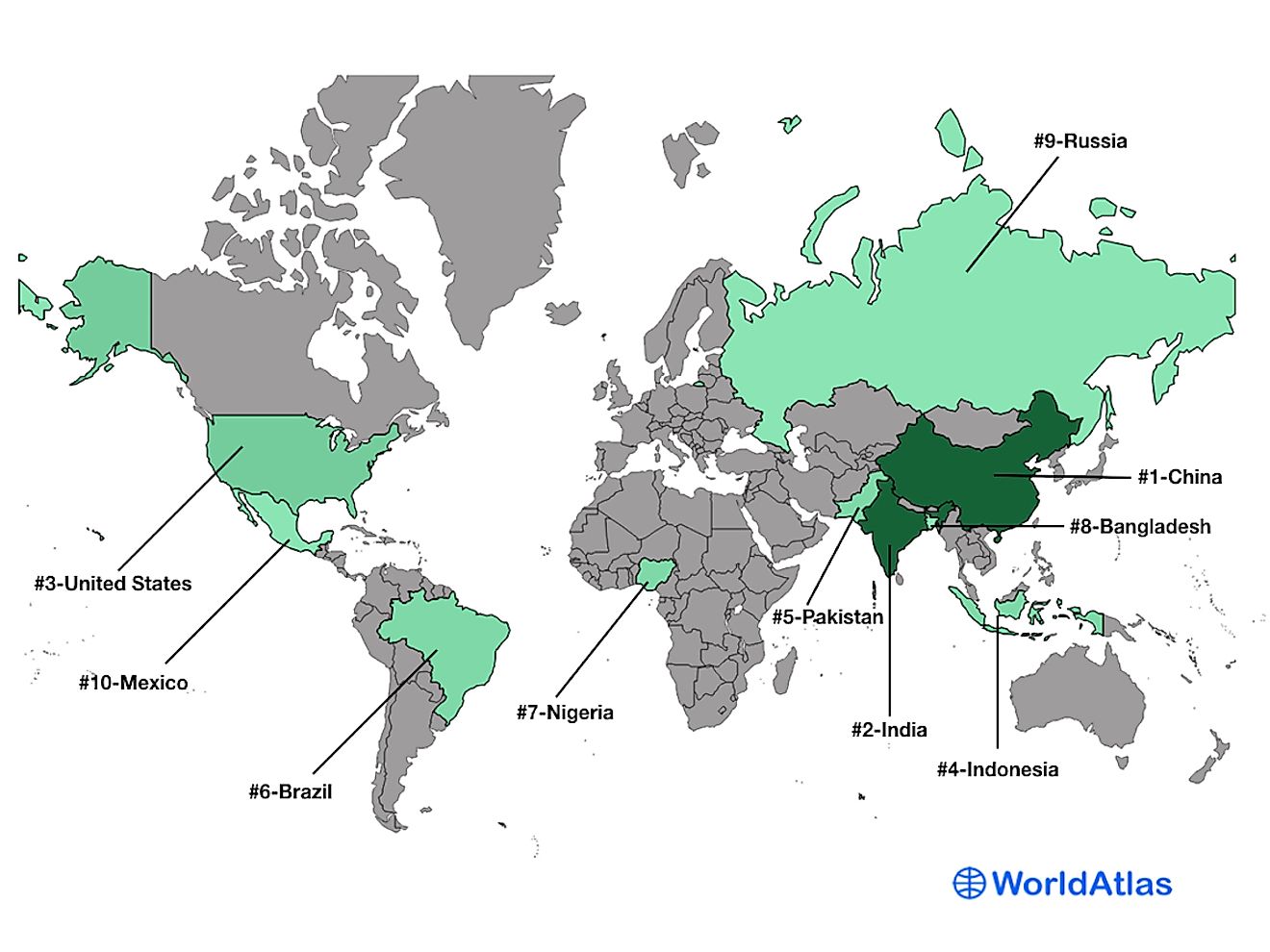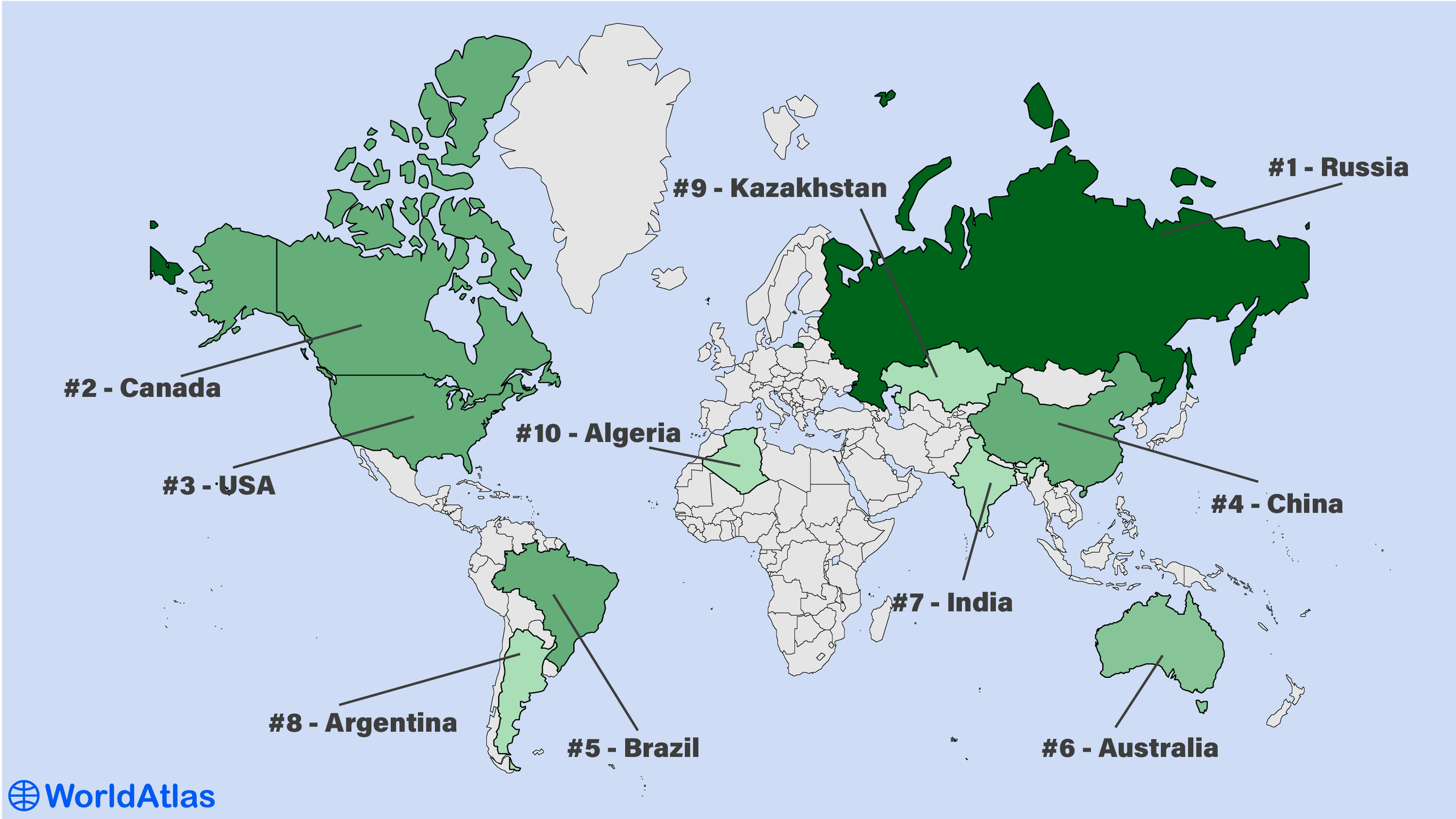
Countries by Area
Planet Earth is the 5th largest planet on the solar system, with a total surface area of approximately 510.1 million km2. About 29.2% or 149 million km2 of the Earth’s surface is dry land, while the rest of the surface is covered by water.
The Earth’s surface is divided into large land masses known as continents. The continents are further subdivided into countries, some of which span over large surfaces. Countries are defined by their borders. A country’s political and natural borders determine its physical territory or size. A political boundary is an imaginary line separating one political entity or country from another.
Countries can be ranked by total surface area or land area. Total surface area include the land area and territorial waters belonging to a country. The world’s three largest countries by total area are Russia, Canada, and the US. Together, these countries occupy roughly 7% of the total Earth surface. The three smallest countries are the Vatican City, Monaco, and Nauru. Historically, the largest country or empire was the British Empire, which had influence over 24% of the total Earth Surface.
Contents:
- 10 Largest Countries In The World
- Is China Bigger Than The US?
- How Big Is Antarctica Compared To The World's Largest Countries?
- The Five Smallest Countries in the World
- Biggest Countries And Empires Of The Past
- Countries Of The World By Size
10 Largest Countries In The World

The world's ten largest countries cover a total area of approximately 85.74 million km2 or 16.8% of the Earth's total surface area or 49.7% of the total land area of the planet.
Rank |
Country |
Total Area in km2 | Land Area in km2 | Water Area in km2 |
|---|---|---|---|---|
|
1 |
Russia |
17,098,242 |
16,377,742 | 720,500 |
|
2 |
Canada |
9,984,670 |
9,093,507 | 891,163 |
|
3 |
United States |
9,833,517 |
9,147,593 | 685,924 |
|
4 |
China |
9,596,960 |
9,326,410 | 270,550 |
|
5 |
8,515,770 |
8,358,140 | 157,630 | |
|
6 |
Australia |
7,741,220 |
7,682,300 | 58,920 |
|
7 |
India |
3,287,263 |
2,973,193 | 314,070 |
|
8 |
2,780,400 |
2,736,690 | 43,710 | |
|
9 |
2,724,900 |
2,699,700 | 25,200 | |
|
10 |
Algeria |
2,381,740 |
2,381,740 | 0 |
Russia is the largest country in the world with a total area of approximately 17.1 million km2. Of Russia’s total surface area, water accounts for 720,500 km2. Russia is approximately 1.8 times the size of the US.
Canada is the largest country in the Americas and the world’s second-largest country after Russia with a total area of approximately 9.98 million km2. About 9% of Canada’s total surface area is covered with water. Canada is slightly larger than the US.
Canada is followed closely by the United States of America, which has a total surface area of 9.83 million km2 (excluding the overseas territories). However, only 9.1 million km2 of the US total surface area is land. The rest of the area is covered in water. The US is about half the size of Russia and the continent of South America, sligthly larger than Brazil and China, and over twice the size of the European Union.
China is the largest country in Asia and the world’s fourth-largest country, with an area of approximately 9.6 million km2. However, when it comes to total land area, China is slightly larger than the US, covering approximately 9.3 million km2.
Brazil and Australia are the 5th and 6th largest countries with total areas of about 8.5 million and 7.7 million km2 respectively. Brazil’s 157,630 km2 and Australia’s 58,920 km2 are covered in water.
India, the world’s second-most populous country, has a total area of approximately 3.3 million km2, making it the world’s 7th largest country. Just about 314,000 km2 of India’s total surface is covered by water. India is slightly over one-third the size of the US.
Argentina, Kazakhstan and Algeria complete the list of the world's ten largest countries, with surface areas of 2.78 million, 2.72 million and 2.36 million km2 respectively. Only about 43,710 km2 of Argentina's surface area is covered by water, while Kazakhstan water bodies cover a total area of 25,200 km2. Algeria has no water area. Argentina and Kazakhstan's combined area is slightly larger than one-half of the US. Algeria is slightly less than 3.5 times the size of Texas.
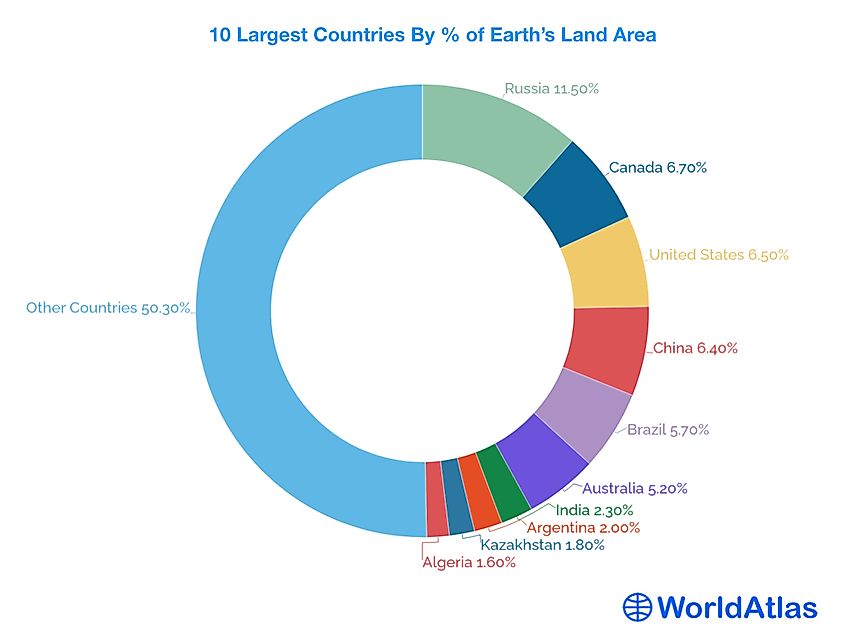
Some Sources Consider China Larger Than The US
Countries worldwide can be ranked using different indices, including total surface area, land area, population, population density, size of the economy, and so much more. It is not a secret that China and the US have always competed for leadership in world affairs, with each aiming to outdo the other.
One of the areas that will remain a topic of debate as long as the two countries exist is; "which is the larger country?" While there is authentic data to settle the argument, it depends on who is interpreting the data; Chinese or American. According to numerous sources, including the CIA World Factbook, the US is the third-largest country after Russia and Canada by total surface area. The US has a total area of approximately 9.8 million km2. It is closely followed by China, with a total surface area of approximately 9.6 million km2. The total surface area includes land area and water surface.
However, China has an edge over the US when it comes to total land area. China’s total land area is approximately 9.3 million km2, while the US land area is 9.1 million km2. Therefore, China is approximately 2% larger than the US in terms of land area.
How Big Is Antarctica Compared To The World's Largest Countries?
Antarctica is the coldest, brightest, windiest, driest, and highest continent in the world. It is located mostly to the south of the Antarctic Circle and has a coastline of approximately 18,000 km. Antarctica is almost entirely covered by a thick ice sheet and accounts for about 90% of the Earth’s ice. If the ice covering the region were to melt right now, the sea level worldwide would be raised by 200 feet. But, how big is Antarctica?
Antarctica is the world’s 5th largest continent after Asia, Africa, and the Americas. It covers a total area of approximately 14.2 million km2, of which approximately 13,915 km2 or 98% is ice-covered. Antarctica’s surface area is almost 1.5 times that of the United States. It is roughly the size of the US (9.8 mil. km2) and India (3.3 km2) combined. Russia (17.1 mil. km2) is the only country larger than Antarctica. It is worth noting that Antarctica is the 5th largest continent by area but the least inhabited region.
The Five Smallest Countries in the World
The world's five smallest countries have a combined total area of approximately 110.44 km2, about 36 times smaller than the US’ smallest state (Rhode Island).
Vatican City, an enclave within Rome, Italy, is the smallest country in the world with a total area of approximately 0.44 km2. It is interesting to note that Vatican City is only about 0.7 times the size of the National Mall in Washington, DC, US.
The Principality of Monaco, a city-state within France, is the world’s second-smallest country, covering a total area of approximately 2 km2. It has a coastline of about 4.1 km and a land border of only 5.5 km. It is about thrice the size of the National Mall.
Nauru is the smallest country not categorized as a city-state. It is also the smallest republic and the smallest island country. It is the 3rd smallest country with an area of approximately 21 km2, with a coastline of about 30 km. Nauru does not share its land borders with any country. It is only 0.1 times the size of Washington, DC.
Tuvalu and San Marino are the 4th and 5th smallest countries, with a total area of approximately 26 and 61 km2 respectively. Tuvalu is surrounded by the Pacific Ocean and is located between Australia and Hawaii and has a 24-km coastline. San Marino is located in Southern Europe and is surrounded by Italy. San Marino is about one-third the size of Washington, DC.
| Rank | Country | Total Area in km2 |
|---|---|---|
| 1 | Vatican City | 0.44 |
| 2 | Principality of Monaco | 2 |
| 3 | Nauru | 21 |
| 4 | Tuvalu | 26 |
| 5 | San Marino | 61 |
Biggest Countries And Empires Of The Past
Some of the countries existing today as individual states once existed as one large sovereign state or empire. However, due to war, conflicts, uprising, rebellion, and annexation, these sovereign states dissolved into individual states. Some of these previously large countries or empires that no longer exist are;
British Empire - 35.5 million km2
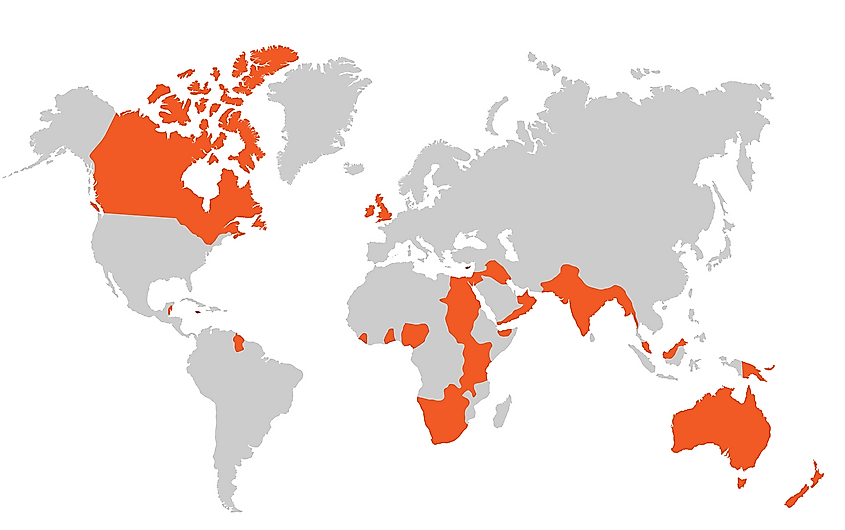
The British Empire was the world’s largest empire in history and had influence in almost all the continents. The empire comprised colonies, dominions, protectorates, territories, and mandates administered by the UK. By 1920, the British Empire had influence over 35.5 million km2or 24% of the Earth’s land area. The empire’s land area was almost four times that of the modern US or twice as large as Russia. At its peak (1913), the empire had a total population of about 412 million, or 23% of the world’s population.
Mongol Empire - 24 million km2
Although the British Empire was the world’s largest empire in history, the Mongol Empire was the largest contiguous land empire. The empire existed up to 1309 and covered 24 million km2 or 16% of the Earth’s total land area. It stretched from East Asia to the Arctic and covered much of Eastern and Central Europe. The Mongol Empire was almost three times larger than the US.
Russian Empire - 22.8 million km2
The Russian Empire existed from 1721 to 1917 and stretched over Asia, North America, and Europe. It was the third-largest empire by total area of influence, covering approximately 22.8 million km2 or 15.3% of the Earth’s total land area. The empire was only about 5 million km2 larger than Russia SFSR (present-day Russia) and 0.4 million km2 larger than the subsequent Soviet Union.
The Soviet Union - 22.4 million km2
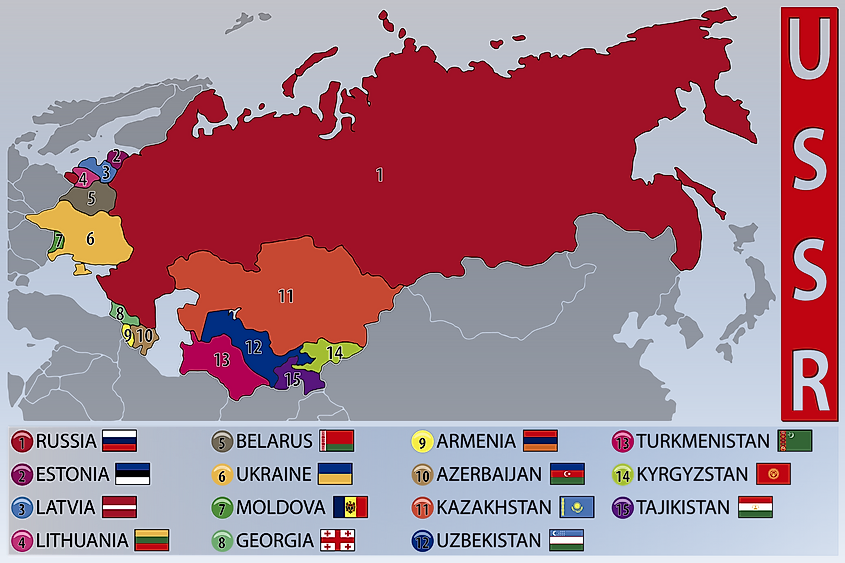
The Soviet Union, commonly known as the USSR, existed between 1922 and 1991. It was a union of several Soviet republics governed by the Communist Party. Although Moscow was the capital, the USSR had influence over an area of approximately 22.4 million km2 or about 15% of the Earth’s total land area, and a population of over 286.7 million people. The USSR was about 5 million km2 larger than present-day Russia and 2.5 times larger than the US. The Soviet Union disintegrated into at least 15 countries, including Russia, Ukraine, Lithuania, Estonia, Kazakhstan, Latvia, Moldova, Armenia, Belarus, Georgia, Azerbaijan, Kyrgyzstan, Tajikistan, Uzbekistan, and Turkmenistan.
Qing Dynasty - 4.7 million km2
Qing Dynasty was China’s last imperial dynasty that ruled China proper for almost three centuries between 1644 and 1912. It was the world’s 4th largest empire, influencing an area of approximately 14.7 million km2, or 9.9% of the Earth’s total land area. The empire’s total land area was equivalent to the current area covered by Antarctica and almost 1.5 times larger than the US. Qing Dynasty was succeeded by the Republic of China.
Republic Of China - 11.4 million km2
The Republic of China (ROC) was a short-lived state that existed between 1912 and 1949, after which it was relocated to the island of Taiwan. By 1949, ROC was the world’s most populous country with 549 million people. It covered an area of approximately 11.4 million km2 or 7.7% of the Earth’s total land area. ROC was about 2 million km2 larger than the US.
Spanish Empire - 13.7 million km2
The Spanish Empire existed between 1499 and 1976 and influenced several overseas territories in Asia, Africa, and Europe. It was one of the largest empires, covering approximately 13.7 million km2, or 9.2% of the Earth’s total land area. The total area occupied by the empire was almost 1.5 times the size of the US and slightly less than modern-day Russia. The Spanish Empire was succeeded by several countries and territories, including the Kingdom of Spain, Bolivia, Republic of Chile, and Equatorial Guinea.
Nazi Germany (The Greater German Reich) - 0.8 million km2
Nazi Germany was a German state that existed from 1933 to 1945, during Adolf Hitler’s reign. It influenced an area of approximately 823,505 km2 in 1940 (over ten times smaller than the US), with a population of over 105 million people. Nazi Germany was dissolved in 1945 and its former territories now consist of Germany and Austria, and parts of other countries such as France, Poland, Luxembourg, Belarus, Denmark, and others.
Countries Of The World By Size
| Rank | Country | Total Area in km2 |
|---|---|---|
|
1 |
17,098,242 |
|
|
2 |
9,984,670 |
|
|
3 |
9,833,517 |
|
|
4 |
9,596,960 |
|
|
5 |
8,515,770 |
|
|
6 |
7,741,220 |
|
|
7 |
India |
3,287,263 |
|
8 |
2,780,400 |
|
|
9 |
2,724,900 |
|
|
10 |
2,381,740 |
|
|
11 |
2,344,858 |
|
|
12 |
2,149,690 |
|
|
13 |
1,964,375 |
|
|
14 |
Indonesia |
1,904,569 |
|
15 |
1,861,484 |
|
|
16 |
1,759,540 |
|
|
17 |
1,648,195 |
|
|
18 |
1,564,116 |
|
|
19 |
1,285,216 |
|
|
20 |
1,284,000 |
|
|
21 |
1,267,000 |
|
|
22 |
1,246,700 |
|
|
23 |
1,240,192 |
|
|
24 |
1,219,090 |
|
|
25 |
1,138,910 |
|
|
26 |
1,104,300 |
|
|
27 |
1,098,581 |
|
|
28 |
1,030,700 |
|
|
29 |
1,001,450 |
|
|
30 |
947,300 |
|
|
31 |
923,768 |
|
|
32 |
912,050 |
|
|
33 |
824,292 |
|
|
34 |
799,380 |
|
|
35 |
796,095 |
|
|
36 |
783,562 |
|
|
37 |
756,102 |
|
|
38 |
752,618 |
|
|
39 |
716,550 |
|
|
40 |
676,578 |
|
|
41 |
652,230 |
|
|
42 |
644,329 |
|
|
43 |
643,801 |
|
|
44 |
637,657 |
|
|
45 |
622,984 |
|
|
46 |
603,550 |
|
|
47 |
587,041 |
|
|
48 |
581,730 |
|
|
49 |
580,367 |
|
|
50 |
527,968 |
|
|
51 |
513,120 |
|
|
52 |
505,370 |
|
|
53 |
488,100 |
|
|
54 |
475,440 |
|
|
55 |
462,840 |
|
|
56 |
450,295 |
|
|
57 |
447,400 |
|
|
58 |
438,317 |
|
|
59 |
406,752 |
|
|
60 |
390,757 |
|
|
61 |
377,915 |
|
|
62 |
357,022 |
|
|
63 |
342,000 |
|
|
64 |
338,145 |
|
|
65 |
331,210 |
|
|
66 |
329,847 |
|
|
67 |
323,802 |
|
|
68 |
322,463 |
|
|
69 |
312,685 |
|
|
70 |
309,500 |
|
|
71 |
301,340 |
|
|
72 |
300,000 |
|
|
73 |
283,561 |
|
|
74 |
274,200 |
|
|
75 |
268,838 |
|
|
76 |
267,667 |
|
|
77 |
245,857 |
|
|
78 |
United Kingdom |
243,610 |
|
79 |
241,038 |
|
|
80 |
238,533 |
|
|
81 |
238,391 |
|
|
82 |
236,800 |
|
|
83 |
Guyana |
214,969 |
|
84 |
207,600 |
|
|
85 |
199,951 |
|
|
86 |
196,722 |
|
|
87 |
187,437 |
|
|
88 |
181,035 |
|
|
89 |
176,215 |
|
|
90 |
163,820 |
|
|
91 |
163,610 |
|
|
92 |
148,460 |
|
|
93 |
147,181 |
|
|
94 |
144,100 |
|
|
95 |
131,957 |
|
|
96 |
130,370 |
|
|
97 |
120,538 |
|
|
98 |
118,484 |
|
|
99 |
117,600 |
|
|
100 |
112,622 |
|
|
101 |
112,090 |
|
|
102 |
111,369 |
|
|
103 |
110,879 |
|
|
104 |
110,860 |
|
|
105 |
108,889 |
|
|
106 |
103,000 |
|
|
107 |
99,720 |
|
|
108 |
93,028 |
|
|
109 |
92,090 |
|
|
110 |
89,342 |
|
|
111 |
86,600 |
|
|
112 |
83,871 |
|
|
113 |
83,600 |
|
|
114 |
78,867 |
|
|
115 |
77,474 |
|
|
116 |
75,420 |
|
|
117 |
71,740 |
|
|
118 |
70,273 |
|
|
119 |
69,700 |
|
|
120 |
65,610 |
|
|
121 |
65,300 |
|
|
122 |
64,589 |
|
|
123 |
56,785 |
|
|
124 |
56,594 |
|
|
125 |
Bosnia and Herzegovina |
51,197 |
|
126 |
51,100 |
|
|
127 |
49,035 |
|
|
128 |
48,670 |
|
|
129 |
45,228 |
|
|
130 |
43,094 |
|
|
131 |
41,543 |
|
|
132 |
41,277 |
|
|
133 |
38,394 |
|
|
134 |
36,125 |
|
|
135 |
33,851 |
|
|
136 |
30,528 |
|
|
137 |
30,355 |
|
|
138 |
29,743 |
|
|
139 |
28,896 |
|
|
140 |
28,748 |
|
|
141 |
28,051 |
|
|
142 |
27,830 |
|
|
143 |
27,750 |
|
|
144 |
Rwanda |
26,338 |
|
145 |
North Macedonia |
25,713 |
|
146 |
23,200 |
|
|
147 |
22,966 |
|
|
148 |
21,937 |
|
| 149 |
21,041 |
|
|
150 |
20,273 |
|
|
151 |
18,274 |
|
|
152 |
17,818 |
|
|
153 |
Eswatini |
17,364 |
|
154 |
14,874 |
|
|
155 |
13,880 |
|
|
156 |
13,812 |
|
|
157 |
12,189 |
|
|
158 |
11,586 |
|
|
159 |
11,300 |
|
|
160 |
10,991 |
|
|
161 |
10,400 |
|
|
162 |
9,251 |
|
|
163 |
Palestine |
6,020 |
|
164 |
5,765 |
|
|
165 |
5,128 |
|
|
166 |
Cabo Verde |
4,033 |
|
167 |
2,831 |
|
|
168 |
2,586 |
|
|
169 |
2,235 |
|
|
170 |
2,040 |
|
|
171 |
964 |
|
|
172 |
811 |
|
|
173 |
760 |
|
|
174 |
751 |
|
|
175 |
747 |
|
|
176 |
719 |
|
|
177 |
Micronesia, Federated States of |
702 |
|
178 |
616 |
|
|
179 |
468 |
|
|
180 |
459 |
|
|
181 |
455 |
|
|
182 |
Antigua and Barbuda |
443 |
|
183 |
430 |
|
|
184 |
389 |
|
|
185 |
344 |
|
|
186 |
316 |
|
|
187 |
298 |
|
|
188 |
261 |
|
|
189 |
181 |
|
|
190 |
160 |
|
|
191 |
61 |
|
|
192 |
Tuvalu |
26 |
|
193 |
21 |
|
|
194 |
2 |
|
|
195 |
Vatican City |
0.44 |
Source: United Nations Statistics
Territories and Dependencies
The following table shows the area of territories and dependencies. These geographic entities are not strictly considered to be countries, but rather are related to other countries.
| Rank | Territory/Dependency | Related Country | Total Area in km2 |
|---|---|---|---|
|
1 |
Denmark |
2,166,086 |
|
|
2 |
Svalbard |
Norway |
62,045 |
|
3 |
Taiwan |
China |
35,980 |
|
4 |
France |
18,575 |
|
|
5 |
Falkland Islands (Islas Malvinas) |
United Kingdom |
12,173 |
|
6 |
Kosovo |
Disputed, claimed by Serbia |
10,887 |
|
7 |
Puerto Rico |
United States |
9,104 |
|
8 |
France |
4,167 |
|
|
9 |
South Georgia and South Sandwich Islands |
United Kingdom |
3,903 |
|
10 |
Virgin Islands |
United States |
1,910 |
|
12 |
Faroe Islands |
Denmark |
1,393 |
|
13 |
China |
1,108 |
|
|
14 |
United Kingdom |
948 |
|
|
15 |
Isle of Man |
United Kingdom |
572 |
|
16 |
Guam |
United States |
544 |
|
17 |
United States |
464 |
|
|
18 |
Curacao |
Netherlands |
444 |
|
19 |
Heard Island and McDonald Islands |
Australia |
412 |
|
20 |
Saint Helena, Ascension, and Tristan da Cunha |
United Kingdom |
394 |
|
21 |
Jan Mayen |
Norway |
377 |
|
22 |
Cayman Islands |
United Kingdom |
264 |
|
23 |
New Zealand |
260 |
|
|
24 |
Saint Pierre and Miquelon |
France |
242 |
|
25 |
Cook Islands |
New Zealand |
236 |
|
26 |
United States |
224 |
|
|
27 |
Aruba |
Netherlands |
180 |
|
28 |
British Virgin Islands |
United Kingdom |
151 |
|
29 |
France |
142 |
|
|
30 |
Christmas Island |
Australia |
135 |
|
31 |
Dhekelia |
United Kingdom |
131 |
|
32 |
Akrotiri |
United Kingdom |
123 |
|
33 |
Jersey |
United Kingdom |
116 |
|
34 |
United Kingdom |
102 |
|
|
35 |
Anguilla |
United Kingdom |
91 |
|
36 |
Guernsey |
United Kingdom |
78 |
|
37 |
British Indian Ocean Territory |
United Kingdom |
60 |
|
38 |
Saint Martin |
France |
54 |
|
39 |
Bermuda |
United Kingdom |
54 |
|
40 |
Bouvet Island |
Norway |
49 |
|
41 |
Pitcairn Islands |
United Kingdom |
47 |
|
42 |
Norfolk Island |
Australia |
36 |
|
43 |
Sint Maarten |
Netherlands |
34 |
|
44 |
Macau |
China |
28 |
|
45 |
Saint Barthelemy |
France |
25 |
|
46 |
Cocos (Keeling) Islands |
Australia |
14 |
|
47 |
Tokelau |
New Zealand |
12 |
|
48 |
Paracel Islands |
Desputed between China, Vietnam, and Taiwan |
8 |
|
49 |
Gibraltar |
United Kingdom |
7 |
|
50 |
Wake Island |
Claimed by the US and Marshall Islands |
7 |
|
51 |
Clipperton Island |
France |
6 |
|
52 |
Navassa Island |
Desputed between the US and Haiti |
5 |
|
53 |
Ashmore and Cartier Islands |
Australia |
5 |
|
54 |
Spratly Islands |
Disputed between China, Malasyia, Brunei, Vietnam, Philippines, and Taiwan |
5 |
|
55 |
Coral Sea Islands |
Australia |
3 |
Source: United Nations Statistics
